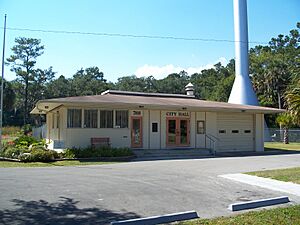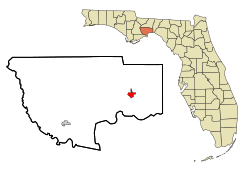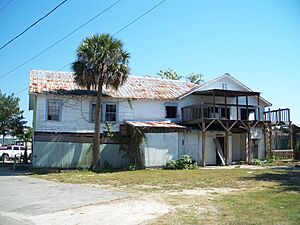St. Marks, Florida facts for kids
Quick facts for kids
St. Marks, Florida
San Marcos de Apalache
|
|
|---|---|

St. Marks City Hall
|
|

Location in Wakulla County and the state of Florida
|
|
| Country | |
| State | |
| County | Wakulla |
| Settled by Spanish Florida (San Marcos de Apalache) | 1679–1783 |
| Settled by the US (Fort St. Marks) |
1818–1821 |
| Incorporated (City of St. Marks) |
1963 |
| Government | |
| • Type | Commission-Manager |
| Area | |
| • Total | 1.97 sq mi (5.09 km2) |
| • Land | 1.96 sq mi (5.07 km2) |
| • Water | 0.01 sq mi (0.02 km2) |
| Elevation | 10 ft (3 m) |
| Population
(2020)
|
|
| • Total | 274 |
| • Density | 139.87/sq mi (54.01/km2) |
| Time zone | UTC-5 (Eastern (EST)) |
| • Summer (DST) | UTC-4 (EDT) |
| FIPS code | 12-62825 |
| GNIS feature ID | 0290282 |
St. Marks is a small city in Wakulla County, Florida, United States. It's part of the wider Tallahassee area. St. Marks is located on the Florida Panhandle in North Florida, right along the Gulf of Mexico. In 2020, the city had a population of 274 people.
Contents
Geography and Location
St. Marks is located at about 30.159244 degrees North and 84.207152 degrees West.

The city covers a total area of about 1.9 square miles (5.0 square kilometers). Most of this area is land, with a very small part being water.
Climate in St. Marks
The weather in St. Marks is known for its hot and humid summers. Winters are usually mild. This type of weather is called a humid subtropical climate.
History of St. Marks
St. Marks has a very long and interesting history. It was first known as San Marcos de Apalache. The Spanish founded this town in the 1600s when Florida was under Spanish rule. It was an important trading post and a Gulf port. Forts were built here by the Spanish many times. These forts were even used during the American Civil War.
Important Events in St. Marks History
A famous event happened in 1818. During a trip into Spanish Florida, Andrew Jackson ordered the execution of two British citizens, Robert Chrystie Ambrister and Alexander George Arbuthnot, at the old fort. He also ordered the execution of a Muscogee (Creek) religious leader known as Francis the Prophet. This event almost caused big problems between the United States and other countries. Today, you can visit San Marcos de Apalache Historic State Park to learn about the old fort.
After the United States took over Spanish Florida in 1821, St. Marks became a center for American trade. The town later moved slightly up the St. Marks River to where it is today. The old fort site was even used as a hospital for sailors during yellow fever outbreaks. During the Civil War, Confederate forces built defenses there. You can still see these earthworks at the historic state park. The park also has old Spanish stonework. This stone was likely taken from nearby quarries in the 1730s.
St. Marks Lighthouse
The St. Marks Light lighthouse was built around 1830 by the U.S. government. It was made using limestone from the local quarries. The lighthouse, which has been rebuilt a few times, stands at the mouth of the river. It's about six miles from town and you can drive to it. The lighthouse, like San Marcos de Apalache, is listed on the National Register of Historic Places because of its historical importance.
Early Port Life
In the early 1800s, St. Marks was a busy seaport for central Florida and southern Georgia. A writer named Ellen Call Long described the port around 1830. She said it was a "quaint little village" with buildings mostly built on stilts, as if ready to float away with the tide.
First Florida Railroad
Florida's first railroad, the Tallahassee Railroad, connected St. Marks with Tallahassee, the capital. Tallahassee is about 20 miles inland. This railroad was built around 1836. Before the Civil War, it was used to export cotton from central Florida through the port of St. Marks.
Over time, the port of St. Marks became less important. It was eventually surpassed by the larger port of Apalachicola in the 1800s.
City Incorporation and Modern Use
The City of St. Marks officially became a city in 1963. The old railroad line is now a paved trail called the Tallahassee-St. Marks Historic Railroad State Trail. This trail is about 16 miles long and is popular for biking and horseback riding. It ends at the St. Marks waterfront.
In 2005, Hurricane Dennis caused a large storm surge that severely flooded St. Marks. Many local businesses and homes were damaged by the saltwater.
Population and People
| Historical population | |||
|---|---|---|---|
| Census | Pop. | %± | |
| 1850 | 189 | — | |
| 1930 | 217 | — | |
| 1970 | 366 | — | |
| 1980 | 286 | −21.9% | |
| 1990 | 307 | 7.3% | |
| 2000 | 272 | −11.4% | |
| 2010 | 293 | 7.7% | |
| 2020 | 274 | −6.5% | |
| U.S. Decennial Census | |||
St. Marks first appeared in the U.S. census in 1850, with 189 people living there.
Recent Population Changes
| Race | Pop 2010 | Pop 2020 | % 2010 | % 2020 |
|---|---|---|---|---|
| White (NH) | 284 | 242 | 96.93% | 88.32% |
| Black or African American (NH) | 5 | 4 | 1.71% | 1.46% |
| Native American or Alaska Native (NH) | 1 | 0 | 0.34% | 0.00% |
| Asian (NH) | 1 | 3 | 0.34% | 1.09% |
| Pacific Islander or Native Hawaiian (NH) | 0 | 0 | 0.00% | 0.00% |
| Some other race (NH) | 0 | 1 | 0.00% | 0.36% |
| Two or more races/Multiracial (NH) | 2 | 17 | 0.68% | 6.20% |
| Hispanic or Latino (any race) | 0 | 7 | 0.00% | 2.55% |
| Total | 293 | 274 |
In 2020, there were 274 people living in St. Marks. There were 167 households and 140 families. Back in 2010, the city had 293 people and 124 households.
See also
 In Spanish: St. Marks (Florida) para niños
In Spanish: St. Marks (Florida) para niños


